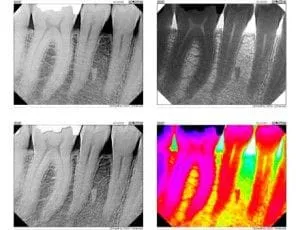How Do Digital Dental X-Rays Work?

Next, an X-ray beam is sent through your teeth and into the sensor, which records the image of your teeth and sends it to the computer. The sensor can then be repositioned to photograph other sections of your teeth.
Why Digital Dental X-rays are better?
The digital dental X-ray system is more sensitive than dental X-ray film systems, so your exposure to X-rays is cut by as much as 90 percent. The large and color-enhanced images let you see what your dentist sees, so it’s easier for you to understand how your dentist will treat your teeth. Your fees don’t include payment for photo chemicals, film processing or film storage. Used photo chemicals and film are not polluting the environment. Your dental checkups take less time, and it is fun to watch this system work! Most patients are amazed.
I don’t want x-rays taken because there is too much radiation. Is this a valid concern?
Most people don’t realize that dental x-rays actually produce very little radiation and with the advent of digital radiography, radiation has gone down even more, by up to 90%. Researchers have concluded that “if a person in an average location in the U.S. were to receive a full-mouth series and panoramic examination every 4 months for the rest of their life, they would incur only the same risk as a person living in Denver who was not exposed to dental radiography”. “Denver is exposed to more atmospheric radiation due to the high elevation of this city”. So remember, you are exposed to radiation naturally, including cosmic radiation from space and radiation from manmade objects such as color television.
I was referred to a specialist and they needed to take their own x-rays. Is this necessary?
As a specialist office, we come across this very often. A patient has been seen by their general dentist and has been referred for specialized treatment. The general dentist took the radiographs they needed to diagnose the patient. The patient then assumes that the specialist should be able to use these same radiographs and refuse further x-rays before they even come in. Again, this poses a bit of a problem. We can only speak for ourselves here, but we always try and obtain the x-rays taken by your dentist. If we can use them, then by all means, we do. However, there are certain situations that warrant taking different radiographs for diagnostic purposes. This is not an area that can be skimped on. A proper diagnosis is mandatory to treat a patient. We can assure you that most dentists don’t take random x-rays. There is a definite purpose.
Do I really need x-rays as often as they are recommended?
Most dentists practice under the code of ethics in dentistry and practice under what is called the “standard of care”. This standard of care has been devised using proven methods and research. An example would be taking standard bitewings at your dentist every six months. This is not an interval that your dentist just made up. This is defined very clearly for our profession, however, x-rays intervals can be tailored to your specific needs or the philosophy of the practice. If you have gum disease, a full mouth series is warranted at least every three years. Again, these are just guidelines because if you are at high risk for a certain disease or are unstable, it is recommended that these x-rays be taken more often, along with potentially other types of x-rays to help diagnose a specific condition. Refusing radiographs when recommended actually puts us in an awkward position because we are then unable to properly diagnose, as we have been trained to do.
Can’t they figure out what is wrong with my tooth without taking x-rays?
Radiography is an indispensable tool for us to use to detect disease and is cautiously used by dentists to provide the greatest benefits to you. We require necessary x-rays to be taken to provide you with the most accurate diagnosis. We will be unable to perform a treatment if you refuse necessary x-ray diagnostic procedures. Looking in the mouth is only one part of the examination. When trying to diagnose dental decay, gum disease, or damage to the nerve, it is impossible to know the extent of the disease without the aid of x-rays. Having said that, x-rays are a two-dimensional image of a three-dimensional mouth, so sometimes the disease can be even further advanced than what is originally thought by your clinical and radiographic examination.
Remember there are serious health risks every time you drive a car or walk across the street. Patients who do not consent to a reasonable amount of dental radiography run a greater risk of dental disease. When left undiagnosed, these conditions may cause an even greater health hazard and medical expenses.
